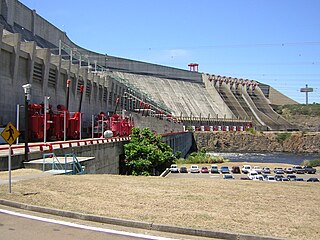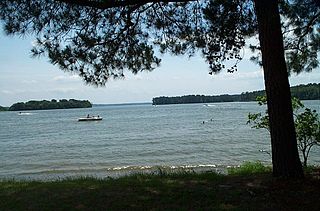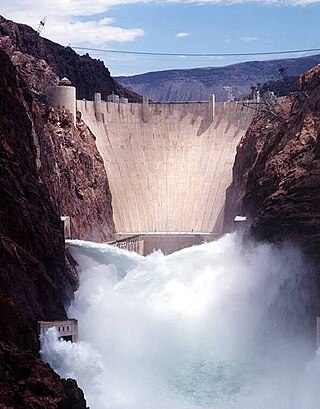See also
- Sustainability
- Biodiversity
- Global warming
- Recycling
- Ecology
- Earth Science
- Natural environment
- Lexington, North Carolina
- Yadkin River
- Hydroelectricity
| Formation | 1954 |
|---|---|
| Type | Non-profit organization |
| Purpose | Environmental protection in High Rock Lake and the surrounding Yadkin Project area |
| Location |
|
Membership | Businesses and individuals |
Main organ | Board of Directors |
Volunteers | Yes |
The High Rock Lake Association, Inc. (also known as "HRLA") is a non-profit group of businesses and individuals with the common goal of protecting the environment at High Rock Lake and the surrounding Yadkin Project area. It was founded in 1954. [1] They have served as the primary representative for individual home owners and businesses in discussions with the federal government and Alcoa during the 2001-2002 and 2007-2008 droughts, and during the 2008 federal contract resolution. The Board of Directors and Officers are all volunteers who serve without pay. Their main source of income is from contributions and member dues.
High Rock Lake is the second largest lake in North Carolina, [2] and is managed under federal license by Alcoa. The licensing process is years long and has traditionally been relicensed for 50 years at a time, with the latest contract expected to be signed in 2008. [3] The last contract was signed in 1958, at a time when virtually no homes were on the lake and the environment was less of a concern than the hydroelectric power the dam provided.
The association is known for protecting the local environment over the years, including fighting to prevent a nuclear power plant from being built on the Yadkin River which would have used up to 75 million gallons of water per day. More recently, the association took a visible role when the lake levels of High Rock Lake dropped to 24 feet below full in 2002. This resulting in a large fish kill and other damage to the environment, as well as the inability of local home owners and visitors to use the facilities of the lake. They have played a significant role in the development of new policies and regulations in the management of the lake levels since the drought. [4] [5] [6]
In 2007 and early 2008, the entire State of North Carolina is experiencing a severe drought similar to that of 2001-2002. [7] During this time, Alcoa has been granted permission to operate under the proposed guidelines of the pending 2008 contract, and the lake levels have been dramatically higher than during the previous drought. [8] These new policies were negotiated in part by the Association, which plays a part in all policy modifications and discussions with the FERC. [9]
Their position has sometimes been controversial, such as opposing the City of Salisbury's demand that Alcoa pay for sedimentation removal [10] and they have publicly stated that their goal is to find a balance between the hydroelectric project, local home owners and businesses, and the environment.

Hydroelectricity, or hydroelectric power, is electricity generated from hydropower. Hydropower supplies one sixth of the world's electricity, almost 4,500 TWh in 2020, which is more than all other renewable sources combined and also more than nuclear power. Hydropower can provide large amounts of low-carbon electricity on demand, making it a key element for creating secure and clean electricity supply systems. A hydroelectric power station that has a dam and reservoir is a flexible source, since the amount of electricity produced can be increased or decreased in seconds or minutes in response to varying electricity demand. Once a hydroelectric complex is constructed, it produces no direct waste, and almost always emits considerably less greenhouse gas than fossil fuel-powered energy plants. However, when constructed in lowland rainforest areas, where part of the forest is inundated, substantial amounts of greenhouse gases may be emitted.

The Yadkin River is one of the longest rivers in the US state of North Carolina, flowing 215 miles (346 km). It rises in the northwestern portion of the state near the Blue Ridge Parkway's Thunder Hill Overlook. Several parts of the river are impounded by dams for water, power, and flood control. The river becomes the Pee Dee River at the confluence of the Uwharrie River south of the community of Badin and east of the town of Albemarle. The river then flows into South Carolina near Cheraw, which is at the Fall Line. The entirety of the Yadkin River and the Great Pee Dee River is part of the Yadkin-Pee Dee River Basin.

The Simón Bolívar Hydroelectric Plant, also Guri Dam, previously known as the Raúl LeoniHydroelectric Plant, is a concrete gravity and embankment dam in Bolívar State, Venezuela, on the Caroni River, built from 1963 to 1969. It is 7,426 metres long and 162 m high. It impounds the large Guri Reservoir with a surface area of 4,250 square kilometres (1,641 sq mi).

Lake Oroville is a reservoir formed by the Oroville Dam impounding the Feather River, located in Butte County, northern California. The lake is situated 5 miles (8 km) northeast of the city of Oroville, within the Lake Oroville State Recreation Area, in the western foothills of the Sierra Nevada. Known as the second-largest reservoir in California, Lake Oroville is treated as a keystone facility within the California State Water Project by storing water, providing flood control, recreation, freshwater releases to assist in controlling the salinity intrusion into the Sacramento-San Joaquin Delta and protecting fish and wildlife.
The Salt River Project (SRP) encompasses two separate entities: the Salt River Project Agricultural Improvement and Power District, an agency of the state of Arizona that serves as an electrical utility for the Phoenix metropolitan area, and the Salt River Valley Water Users' Association, a utility cooperative that serves as the primary water provider for much of central Arizona. It is one of the primary public utility companies in Arizona.

A reservoir is an enlarged lake behind a dam, usually built to store fresh water, often doubling for hydroelectric power generation.

The Tuckertown Reservoir is the reservoir formed by the Tuckertown Dam35°29′05″N80°10′36″W at the North end of Badin Lake and the High Rock Dam 35°36′03″N80°14′06″W at the bottom of High Rock Lake in the Uwharrie Lakes Region in the U.S. state of North Carolina.

Lake Tillery is a reservoir between Falls Reservoir and Blewett Falls Lake in the Uwharrie Lakes Region of North Carolina. It is entirely within Stanly County and Montgomery County, NC. The lake was created by impounding the Pee Dee River, which is created by the confluence of the Yadkin River and the Uwharrie River several miles to the north. Norwood, NC in neighboring Stanly County uses as its town motto "Gateway to Lake Tillery".

High Rock Lake is a reservoir located on the Yadkin River in central North Carolina in the counties of Davidson and Rowan. Built in 1926-27 by the Tallassee Power Company, a wholly owned subsidiary of the Aluminum Company of America (Alcoa), the lake is the northernmost of a series of four hydroelectric projects designed at the time to support the company’s Badin Works, a large aluminum smelting operation located 16 miles downstream in the community of Badin. After the permanent closing of the Badin Works in 2007, Alcoa continued to operate its Yadkin hydroelectric facilities until selling them to Cube Hydro Carolinas in 2016.

Lake Gaston is a reservoir in the eastern United States. Part of the lake is in the North Carolina counties of Halifax, Northampton, and Warren. The part extending into Virginia lies in Brunswick and Mecklenburg counties. Lake Gaston is roughly 35 miles (56 km) long and covers over 20,000 acres (81 km2), with 350 miles (560 km) of shoreline.

Lake Livingston is a reservoir located in Piney Woods in Houston, Madison, Polk, San Jacinto, Trinity and Walker counties in east Texas, United States. Lake Livingston was built and is owned and operated by the Trinity River Authority (TRA) of Texas under contract with the City of Houston for water-supply purposes. The USCG Auxiliary Flotilla 6-9 is also stationed on the lake. The lake is the third-largest lake located in the state of Texas. The Livingston Dam, constructed across the Trinity River about 7 miles (11 km) southwest of the city of Livingston is 2.5 miles (4 km) in length and has an average depth of 55 feet (17 m).
Falls Reservoir is part of the Yadkin River Project in North Carolina and managed by Alcoa as part of their hydroelectric business. It is the last of four reservoirs along a 38-mile (61 km) stretch of the Yadkin River. Falls Reservoir is the smallest of the four reservoirs and covers 204 acres (0.83 km2) and has a shoreline length of 6 miles (9.7 km). The hydroelectric operation was sold to Cube Hydro Carolinas in February 2017.

Renewable energy in Canada represented 17.3% of the Total Energy Supply (TES) in 2020, following natural gas at 39.1% and oil at 32.7% of the TES.

Water resources management (WRM) functions in Argentina are handled by multiple institutions operating at the national, provincial, and river basin level, with a variety of functions and jurisdictions. On the national level, the National Institute for Water and the Environment (INA) and the National Water and Sanitation Utility (AySA) are charged with the duties of researching, water resources preservation, developing services, and implementing water projects.

The Yadkin–Pee Dee River Basin is a large river basin in the eastern United States, covering around 7,221 square miles, making it the second largest in the state of North Carolina. Its headwaters rise near Blowing Rock, North Carolina, and the basin drains to the Atlantic Ocean in Winyah Bay, east of Georgetown, South Carolina.
Alcoa Power Generating, Inc. is a subsidiary of Alcoa Inc., headquartered in Pittsburgh, Pennsylvania. Its three divisions were independent subsidiaries before being consolidated into Alcoa Power Generating, Inc. (APGI). These three projects have produced hydroelectric power and manage impoundments which also provide flood control; recreation, residential and business opportunities; and wildlife habitat.
Brookfield Renewable Partners L.P. is a publicly traded limited partnership that owns and operates renewable power assets, with corporate headquarters in Toronto, Ontario, Canada. It is 60% owned by Brookfield Asset Management.

Hydropower policy in the United States includes all the laws, rules, regulations, programs and agencies that govern the national hydroelectric industry. Federal policy concerning waterpower developed over considerable time before the advent of electricity, and at times, has changed considerably, as water uses, available scientific technologies and considerations developed to the present day; over this period the priority of different, pre-existing and competing uses for water, flowing water and its energy, as well as for the water itself and competing available sources of energy have changed. Increased population and commercial demands spurred this developmental growth and many of the changes since, and these affect the technology's use today.

Most of Kenya's electricity is generated by renewable energy sources. Access to reliable, affordable, and sustainable energy is one of the 17 main goals of the United Nations’ Sustainable Development Goals. Development of the energy sector is also critical to help Kenya achieve the goals in Kenya Vision 2030 to become a newly industrializing, middle-income country. With an installed power capacity of 2,819 MW, Kenya currently generates 826 MW hydroelectric power, 828 geothermal power, 749 MW thermal power, 331 MW wind power, and the rest from solar and biomass sources. Kenya is the largest geothermal energy producer in Africa and also has the largest wind farm on the continent. In March 2011, Kenya opened Africa's first carbon exchange to promote investments in renewable energy projects. Kenya has also been selected as a pilot country under the Scaling-Up Renewable Energy Programmes in Low Income Countries Programme to increase deployment of renewable energy solutions in low-income countries. Despite significant strides in renewable energy development, about a quarter of the Kenyan population still lacks access to electricity, necessitating policy changes to diversify the energy generation mix and promote public-private partnerships for financing renewable energy projects.

Egbert Barry Cornwall Hambley was a British-born mining engineer and power company executive, who worked for much of his career in North Carolina.